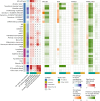Cell-type-specific and disease-associated expression quantitative trait loci in the human lung
- PMID: 38548990
- PMCID: PMC11018522
- DOI: 10.1038/s41588-024-01702-0
Cell-type-specific and disease-associated expression quantitative trait loci in the human lung
Erratum in
-
Author Correction: Cell-type-specific and disease-associated expression quantitative trait loci in the human lung.Nat Genet. 2024 May;56(5):1034. doi: 10.1038/s41588-024-01765-z. Nat Genet. 2024. PMID: 38664563 Free PMC article. No abstract available.
Abstract
Common genetic variants confer substantial risk for chronic lung diseases, including pulmonary fibrosis. Defining the genetic control of gene expression in a cell-type-specific and context-dependent manner is critical for understanding the mechanisms through which genetic variation influences complex traits and disease pathobiology. To this end, we performed single-cell RNA sequencing of lung tissue from 66 individuals with pulmonary fibrosis and 48 unaffected donors. Using a pseudobulk approach, we mapped expression quantitative trait loci (eQTLs) across 38 cell types, observing both shared and cell-type-specific regulatory effects. Furthermore, we identified disease interaction eQTLs and demonstrated that this class of associations is more likely to be cell-type-specific and linked to cellular dysregulation in pulmonary fibrosis. Finally, we connected lung disease risk variants to their regulatory targets in disease-relevant cell types. These results indicate that cellular context determines the impact of genetic variation on gene expression and implicates context-specific eQTLs as key regulators of lung homeostasis and disease.
© 2024. The Author(s).
Conflict of interest statement
J.A.K. reports advisory board fees from Boehringer Ingelheim, nonfinancial study support from Genentech and grant funding from Boehringer Ingelheim. N.E.B. reports consulting fees from Deepcell. L.B.W. has received advisory board fees from CSL Behring, Quark, Bayer and Merck, and has research contracts with Genentech and CSL Behring. T.S.B. reports consulting fees from Orinove, GRI Bio, Morphic and Novelstar Pharmaceuticals, research grants and contracts from Boehringer Ingelheim and Celgene, and nonfinancial study support from Genentech. R.W. reports consultant fees from Genentech and Boehringer Ingelheim. The remaining authors declare no competing interests.
Figures






Update of
-
Cell type-specific and disease-associated eQTL in the human lung.bioRxiv [Preprint]. 2023 Jun 29:2023.03.17.533161. doi: 10.1101/2023.03.17.533161. bioRxiv. 2023. Update in: Nat Genet. 2024 Apr;56(4):595-604. doi: 10.1038/s41588-024-01702-0. PMID: 36993211 Free PMC article. Updated. Preprint.
References
MeSH terms
Grants and funding
LinkOut - more resources
Full Text Sources
Medical
Molecular Biology Databases

